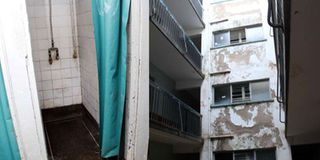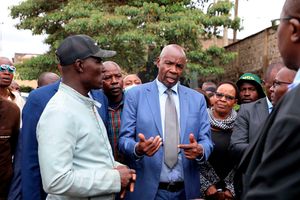High student enrolment has led to shortage of facilities and services

A communal bathroom in the University of Nairobi's Jamuhuri Hostel 4 (right) where two students get to share a sub-divided room at the cost of sh 7, 000 per academic year. October 16, 2014. PHOTO | DIANA NGILA
What you need to know:
- Squalid living quarters, crowding in lecture halls and a shortage of extra-curricular facilities make it difficult for many university students to be the best they can be. Is it any wonder, then, that they are often accused of being half-baked when they they join the job market?
- Cash-strapped thanks to the declining per-student public funding and the fees freeze, public universities introduced “parallel” courses, for which they charge full fees. This resulted in great disparities between the fees paid by state- and self-sponsored students.
- With the surge in student numbers, higher education faces numerous challenges, which hamper its ability to produce top-notch graduates.
When Michael Oduor from Maseno School scored an A plain in the Kenya Certificate of Secondary of Education (KCSE) in 2013, he was elated because he was sure it would set him on the path to the life he had dreamt of. He would get direct admission to university for the degree course of his choice, after which he would be ready for the big world out there.
He did get admitted to Jomo Kenyatta University of Agriculture and Technology (JKUAT) to pursue a degree electrical and electronics engineering, yes, but after a year now, he’s finding life at the university a struggle. Since he missed accommodation on campus, Oduor lives in Juja in a poorly maintained, rented room which threatens to fall apart when it is windy. He pays Sh5,500 for the shared room, which has barely enough space for a reading table. In fact, he cannot move around without getting into his room-mate’s way. The ramshackle washrooms are made of wooden offcuts, and the pit latrines are almost full. He never takes breakfast but saves the little money he has for a meal at the university canteen. To get to class, he walks a dusty, two-kilometre stretch every day, leaving him tired and unable to concentrate fully by the time he gets to class. Oduor cannot wait to finish his studies and move out.
Sadly, his situation is replicated at universities across the country. And with the unemployment situation getting worse, some students are asking themselves whether the rough life they are living is worth their while.
With increased admissions and huge enrolment of self-sponsored students, universities undoubtedly bit off more than they could chew, and especially after they did away with admission based on on-campus accommodation. As a result, the facilities at most universities are overstretched, forcing the students to make do with what is available.

A room in the University of Nairobi's Jamuhuri Hostel 4 where two students get to share a sub-divided room at the cost of Sh7, 000 per academic year. October 16, 2014. PHOTO | DIANA NGILA
The limited resources at the institutions — lecture halls, hostels, reading rooms and even co-curricular facilities — make it difficult for the students to get a quality education. Indeed, with the current enrolment, the lecturer student ratio is a worrying 1:400. In some course units, you have one lecture teaching more than 1,000 students, so he or she has to use a microphone. This raises the question, can quality be guaranteed in such circumstances? Perhaps, that is why universities are churning out “half-baked” graduates.
ACCOMODATION
The accommodation situation is dire. There are a combined 280,000 bed spaces in universities and colleges in the country, compared with a student population of 769,000, according to the latest statistics. And most of the admissions are self-sponsored students, who provide the much-needed resources for the development and sustenance of the institutions’ operations.
The Technical University of Kenya (formerly The Kenya Polytechnic), for instance, has just two hostels: one for men in Nairobi’s South B, and one for women at Community Hill with a combined 1,000 rooms, while the student population is more than 18,600. Those who are lucky enough to get the rooms pay Sh7,200 per semester.
Across town at Kenyatta University, the more than 22,000 students not living on campus seek accommodation in the crowded Kahawa Sukari, Roysambu and Kahawa Wendani estates. But Kilometre 101, or simply KM, an informal, crime-infested neighbourhood located outside the university’s main campus, remains the preferred area of choice for the students.
Meanwhile, Maasai Mara University has more than 3,200 students living in various places around Narok town, which makes access to university facilities difficult.
And Kisii University is facing a major crisis after it increased intake,which saw more than 5,300 students seeking accommodation in the already congested town.
Egerton University cannot house even a third of its students, while JKUAT has more than 7,000 students living in dilapidated dwellings in Juja town, Gashororo and Weitethie. Similarly, Maseno University’s 4,800 students who are not housed on campus have to find alternative accommodation.
The University of Nairobi has 13,000 students living off campus. To improve the situation, it is planning to build a Sh3 billion hostel on Harry Thuku Road to house between 2,000 and 3,000 students, who will pay between Sh50 and100 per day. Similarly, Kenyatta University is to build a Sh1 billion housing complex at its main campus, which will house about 10,000 students.

A communal bathroom in the University of Nairobi's Jamuhuri Hostel 4 where two students get to share a sub-divided room at the cost of sh7, 000 per academic year on October 16, 2014 PHOTO | DIANA NGILA
LACK OF FACILITIES
The proliferation of private universities and colleges in Nairobi’s city centre without recreational space or accommodation has led to a situation where students mostly while away the time on the streets as they wait for their next class.
In June, the Commission for University Education (CUE) said city-based campuses that had not adhered to the prescribed standards and guidelines would be closed. Commission Chairman Henry Thairu said the Universities Standards and Guidelines 2014 must be adhered to, adding that the next purge would target universities in western Kenya. “We have carried it out in Nairobi and its environs and now we head to the Western circuit. What we are asking for is compliance with the standards we have set, which are globally accepted,” Mr Thairu said.
The CUE announced that eight satellite campuses would be closed in a major crackdown to restore order in higher education in Nairobi. The purge targeted St Paul’s University campus at Church House on Moi Avenue, Egerton University’s City Campus, Africa Nazarene University at Agrho House and the South Eastern Kenya University. Others were Dedan Kimathi University of Technology, as well as Multi-Media University of Kenya’s and Masinde Muliro University of Science and Technology’s city campuses.
Following the 88,000 admissions by the Kenya Universities and Colleges Central Placement Service this year, up from last year’s 58,000, most campuses are facing major constraints with regard to teaching space, which they are unlikely to resolve soon.
The level of squalor at many campuses would shock former graduates (now parents), who passed through the institutions of higher learning two decades ago, when the universities accommodated all students on campus, fed them and even gave them allowances.
The increased student population, which is also attributable to the directive that universities implement double intakes back in 2011, has created a conducive market for investment in housing, but questions have arisen regarding the quality.
But while it might look like only the students are affected, the lecturers are not having it easy either. Almost half of the unhoused lecturers commute almost 100 kilometres daily to work. Mr Willis Rono, a lecturer who spends almost four hours commuting, sometimes ends up late for class. “It is tough,” he says.
PROBLEMS ALL AROUND
During the launch of the 2015 examinations by the Kenya National Examinations Council (KNEC), the council’s CEO, Dr Joseph Mbithi Kivilu, said there were 525,802 KCSE candidates. At least 200,000 of them will add pressure to the crisis when they join university.

Geoffrey Limo (left) and his brother Vincent Kemei, students at Moi University, Eldoret doing their assignments at their hostel room on November 13, 2009. They are among hundreds of students who were forced to seek accommodation outside their university compound due accommodation crisis at public universities in the country. PHOTO | FILE
Mr Kennedy Mwangi, an accountant with children at the university, says many campuses still lack effective services such as off-campus housing, shuttle services, security and water supply to match the demand. “This is why many students are living in people’s living rooms, servants’ quarters and verandas. Some of these places lack security, adequate water supply and electricity,” he observes.
Town planner Philip Keita foresees a town planning crisis: “With numerous corrugated iron sheet structures with shared bathrooms and toilets springing up in university neighbourhoods, the places will end up as slums, prompted by the demand for accommodation.”
Meanwhile, psychologist Dr Moses Kerosi of Mount Kenya University predicts a rise in crime: “With limited resources and the need for money for upkeep, drug peddling, prostitution or even running makeshift kiosks where they (students) sell cheap liquor will become more rampant.”
But to Mrs Grace Njeri, who manages a hostel in the city, the crisis is a godsend, because the students are prepared to pay higher rents than regular tenants. “We provide furniture such as beds, mattresses, curtains, reading lamps, in addition to meals served on a pay-as-you-eat basis.”
Kisumu real estate investor Eric Ounga points out that, although investment in student accommodation is still low, it has a lot of potential. “It is the new thing in town since we have very many universities coming up in western Kenya,” he says.
While the Kenya government has been lauded for its efforts in expanding access to higher education, it has also been criticised for not spending enough on expanding facilities to match the demands of increased learners.
Still, World Bank data show that state funding of public universities has nearly tripled in the past four years, rising from $247 (Sh26 bn) million in 2010 to $624 (66 bn) million last year. During this period, enrolment has grown four-fold.
But CUE Secretary Prof David Some says it is still inadequate. “Funding higher education has emerged as one of the biggest concerns in Kenya, with the surge in student numbers. Government subsidies are no longer enough and universities are going into commercial activities.”
The Universities’ Academic Staff Union (UASU) National Treasurer, Ms Edwina Kawaka, regrets that the continued expansion of universities, while well intentioned, has diluted the quality of education.
The government’s inability to match funding with enrolment is one of the reasons it is pushing for a review of public university fees, which have remained unchanged since 1995. During an interview with the media last year, education Cabinet Secretary Prof Jacob Kaimenyi said the current charges were “too low” to sustain quality learning. But the suggestion to increase the fees was strongly opposed by students, who organised a strike to counter it.
Cash-strapped thanks to the declining per-student public funding and the fees freeze, public universities introduced “parallel” courses, for which they charge full fees. This resulted in great disparities between the fees paid by state- and self-sponsored students.
With the surge in student numbers, higher education faces numerous challenges, which hamper its ability to produce top-notch graduates. Issues such as inadequate capacity, a mismatch between the skills acquired and the demands of the job market, gender imbalances, rigid admission criteria and limited opportunities for credit transfer have crippled the sector, economist Irene Ruto, an education consultant, notes. “We risk growing too fast while not dealing with basic problems of the quality of graduates coming out of universities,” she says. “We still have complaints from employers that most of the graduates are half-baked. We need to address these challenges as a country.”
Kenya has largest varsity system in EA
KENYA HAS THE largest university education system in East Africa. The number of universities in the country rose from six public ones in 2003 to 24 in 2014. In total, the country has 54 institutions, nine of which are constituent colleges of public universities and five of private universities. As a result, the number of university students rose from 67,558 in 2003/2004 to about 769,550 in 2015.
According to the last year’s Economic Survey, there was a 28.3 per cent increase in overall university student enrollment from 198,260 in 2011 to 340,550 in 2014. This was higher than the 14.6 per cent, recorded in 2011/2012 because of the double intake implemented in the 2013/2014 academic year.
Female student enrollment rose by 30.5 per cent from 80,560 in 2011/2012 to 186,115 in 2012/2013. During the same period, enrollment in private universities rose by 11.6 per cent from 40,344 in 2011/2012 to 95,023 in the 2013/1204 academic year.
But women’s enrollment declined from 40.1 per cent in 2008/2009 to 37.9 per cent in 2009/2010. To boost the numbers, the joint board has an affirmative action policy, admitting female students with a point less than their male counterparts.
769,550
The combined number of students at universities this year. This is a marked increase from the 2003/2004 enrollment of 67,558. The sharp increase is partly attributable to the double-intake effected in 2011, and partly to an increase in the proliferation of institutions of higher learning.




